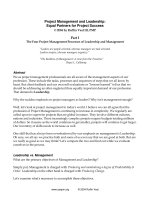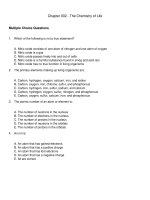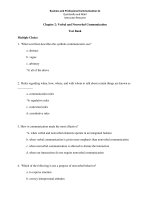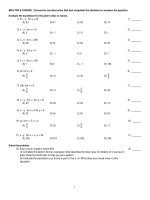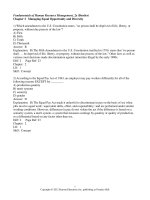Leadership and management for nurses core competencies for quality care 2nd edition anita finkelman test bank
Bạn đang xem bản rút gọn của tài liệu. Xem và tải ngay bản đầy đủ của tài liệu tại đây (169.18 KB, 19 trang )
Finkelman, Leadership and Management for Nurses: Core Competencies for
Quality Care 2nd Edition Test Bank
Chapter 2
Question 1
Type: MCSA
Which option represents a situation exemplifying the need for nurses to become involved in health care planning?
1. The nurse omitted documentation of a surgical dressing change.
2. The nurse must have an advanced practice license to prescribe medications.
3. The nurse administered oral medications to the patient.
4. The nurse discussed do-not-resuscitate decisions with the patient and the family.
Correct Answer: 2
Rationale 1: This scenario represents a violation of standards and a potential malpractice issue, not an issue of
health care planning.
Rationale 2: Changes in legislation and regulation (which might be influenced by nurses involved in health care
planning) affect nursing practice.
Rationale 3: This scenario is unlikely to be altered by change in legislation or regulation.
Rationale 4: This scenario is unlikely to be altered by change in legislation or regulation.
Global Rationale:
Cognitive Level: Applying
Client Need: Safe Effective Care Environment
Client Need Sub:
Nursing/Integrated Concepts: Nursing Process: Implementation
Learning Outcome: LO 01. Explain why nurses should be involved in health care policy.
Question 2
Type: MCSA
Which strategy could the nurse use to avoid disparity in health care delivery?
1. Recognize the cultural issue related to patient care.
2. Request more health plan options.
Finkelman, Leadership and Management for Nurses: Core Competencies for Quality Care 2nd Edition Test Bank
Copyright 2012 by Pearson Education, Inc.
3. Care for more patients even if quality suffers.
4. Campaign for fixed nurse-patient ratios.
Correct Answer: 1
Rationale 1: Disparities often occur because the health care professional does not recognize cultural differences
or has a cultural bias.
Rationale 2: This is a consumer demand related to managed care. The nurse has little effect on this issue.
Rationale 3: This is an unacceptable strategy to nursing.
Rationale 4: This scenario is unlikely to have impact on health disparities.
Global Rationale:
Cognitive Level: Applying
Client Need: Health Promotion and Maintenance
Client Need Sub:
Nursing/Integrated Concepts: Nursing Process: Implementation
Learning Outcome: LO 01. Explain why nurses should be involved in health care policy.
Question 3
Type: MCSA
Which option best illustrates a positive outcome for managed care?
1. Reshaping current policy.
2. Involvement in the political process.
3. Increase in preventative services.
4. Cost-benefit analysis.
Correct Answer: 3
Rationale 1: This is not an outcome of managed care, but rather a part of the political process regarding
legislation.
Rationale 2: While this would provide nurses with input in the direction that health policy takes, it is not likely to
be an outcome of managed care.
Rationale 3: This has been shown to be a positive change in health care delivery that has occurred as a result of
managed care.
Finkelman, Leadership and Management for Nurses: Core Competencies for Quality Care 2nd Edition Test Bank
Copyright 2012 by Pearson Education, Inc.
Rationale 4: This is a technique used to determine costs and benefits of various alternatives before making health
care policy.
Global Rationale:
Cognitive Level: Applying
Client Need: Safe Effective Care Environment
Client Need Sub:
Nursing/Integrated Concepts: Nursing Process: Evaluation
Learning Outcome: LO 01. Explain why nurses should be involved in health care policy.
Question 4
Type: MCSA
The nursing assistant left a side rail down upon exiting the room of a patient who had just returned from the
recovery room postoperatively. What does this scenario most closely illustrate?
1. Personal injury.
2. Criminal intent.
3. Malpractice.
4. Negligence.
Correct Answer: 4
Rationale 1: It is not yet clear that any personal injury has occurred.
Rationale 2: There is no indication that this nursing assistant had any criminal intent when leaving the side rail
down.
Rationale 3: Malpractice is the failure of a professional person to act in accordance with the prevailing
professional standards or failure to foresee consequences that a professional person, having the necessary skill and
education, should foresee.
Rationale 4: Negligence is the failure to act as an ordinary prudent person would under similar circumstances and
is based upon that person’s education and training.
Global Rationale:
Cognitive Level: Analyzing
Client Need: Safe Effective Care Environment
Client Need Sub:
Nursing/Integrated Concepts: Nursing Process: Implementation
Learning Outcome: LO 07. Explain how malpractice and negligence relate to nursing practice.
Question 5
Finkelman, Leadership and Management for Nurses: Core Competencies for Quality Care 2nd Edition Test Bank
Copyright 2012 by Pearson Education, Inc.
Type: MCSA
The risk manager is reviewing these events that occurred over the weekend. Which scenario should the risk
manager be most concerned would represent malpractice?
1. The nurse did not obtain an apical pulse on a patient prior to administering Digoxin 0.25 mg orally.
2. The nurse did not raise the bed when changing the linens for a patient who was up in the chair.
3. A nurse did not obtain consent before drawing blood.
4. The nurse continued to assess the diabetic patient’s blood sugar before each meal.
Correct Answer: 1
Rationale 1: This action is not in accordance with professional standards in assessing an apical pulse prior to
administering Digoxin.
Rationale 2: This action is more likely to harm the nurse than it is to harm the patient.
Rationale 3: This is more likely to be seen as battery than as malpractice.
Rationale 4: This is an appropriate action expected from a professional nurse.
Global Rationale:
Cognitive Level: Analyzing
Client Need: Safe Effective Care Environment
Client Need Sub:
Nursing/Integrated Concepts: Nursing Process: Evaluation
Learning Outcome: LO 07. Explain how malpractice and negligence relate to nursing practice.
Question 6
Type: MCSA
Which scenario is an example of informed consent?
1. The nurse omits diabetic education for a patient who has had diabetes for 10 years.
2. The nurse applies restraints to a patient who is trying to remove the nasogastric tube.
3. The patient understands the surgical procedure that will occur in the morning.
4. The patient asks the nurse for pain medication.
Correct Answer: 3
Rationale 1: This was a negligent action on the part of the nurse.
Finkelman, Leadership and Management for Nurses: Core Competencies for Quality Care 2nd Edition Test Bank
Copyright 2012 by Pearson Education, Inc.
Rationale 2: This could be construed as assault and battery.
Rationale 3: This patient is able to make an informed decision about health care.
Rationale 4: This is a routine nursing intervention and when the nurse brings the medication consent is implied.
Global Rationale:
Cognitive Level: Analyzing
Client Need: Safe Effective Care Environment
Client Need Sub:
Nursing/Integrated Concepts: Nursing Process: Implementation
Learning Outcome: LO 07. Explain how malpractice and negligence relate to nursing practice.
Question 7
Type: MCSA
On admission the patient states, “My son can make health care decisions for me if it is necessary.” What does this
statement imply?
1. The patient has a living will.
2. The son has durable power of attorney.
3. This patient has violated the Patient Self-Determination Act.
4. The patient wishes a do-not-resuscitate status.
Correct Answer: 2
Rationale 1: In a living will there is no person appointed to make decisions. The living will is a statement of the
patient’s wishes in writing.
Rationale 2: The son is a competent person who has been designated to make health care decisions for his parent.
This is a durable power of attorney.
Rationale 3: This act requires that all health care providers ask patients about living wills and durable powers of
attorney. There is no indication that there is any violation.
Rationale 4: There is no indication that this is true.
Global Rationale:
Cognitive Level: Analyzing
Client Need: Safe Effective Care Environment
Client Need Sub:
Nursing/Integrated Concepts: Nursing Process: Planning
Learning Outcome: LO 07. Explain how malpractice and negligence relate to nursing practice.
Finkelman, Leadership and Management for Nurses: Core Competencies for Quality Care 2nd Edition Test Bank
Copyright 2012 by Pearson Education, Inc.
Question 8
Type: MCSA
Which situation illustrates the ethical concept of autonomy?
1. The patient is instructed on the technique of insulin administration.
2. The patient is asked to choose from which arm to have blood drawn.
3. The patient’s information can be used for research purposes.
4. The patient is informed of privacy rights.
Correct Answer: 2
Rationale 1: This is provision of patient education.
Rationale 2: Autonomy means that the patient has the right to make decisions about health care.
Rationale 3: This concerns the matter of patient privacy.
Rationale 4: This concerns the matter of patient privacy, not autonomy.
Global Rationale:
Cognitive Level: Applying
Client Need: Safe Effective Care Environment
Client Need Sub:
Nursing/Integrated Concepts: Nursing Process: Implementation
Learning Outcome: LO 08. Apply ethical decision making to management situations.
Question 9
Type: MCSA
Which nursing action best illustrates the ethical concept of beneficence?
1. Providing a walker for a patient prior to ambulating in the hall.
2. Allowing the patient to choose what time to have a shower.
3. Asking the patient about the existence of a living will or durable power of attorney.
4. Continually communicating with the patient regarding procedures.
Correct Answer: 1
Rationale 1: This is the principle of doing good, inflicting no harm.
Finkelman, Leadership and Management for Nurses: Core Competencies for Quality Care 2nd Edition Test Bank
Copyright 2012 by Pearson Education, Inc.
Rationale 2: This is an example of patient autonomy.
Rationale 3: This is required by the Patient Self-Determination Act.
Rationale 4: This illustrates informed consent.
Global Rationale:
Cognitive Level: Applying
Client Need: Safe Effective Care Environment
Client Need Sub:
Nursing/Integrated Concepts: Nursing Process: Implementation
Learning Outcome: LO 08. Apply ethical decision making to management situations.
Question 10
Type: MCSA
Which action, taken by the nurse, best illustrates the ethical concept of justice?
1. The nurse witnesses consent prior to a surgical procedure for a patient.
2. The nurse advises the patient to take slow, deep breaths to try to relax before a urinary catheter is inserted.
3. The nurse provides discharge teaching to a postoperative patient and spends time with a patient who is
depressed.
4. The nurse works with a physician to solve a patient problem.
Correct Answer: 3
Rationale 1: This is a standard role of the nurse and is associated with the legality of informed consent.
Rationale 2: This illustrates the principle of beneficence.
Rationale 3: This is an example of justice because the nurse is providing fair treatment and giving time to both
patients.
Rationale 4: This is an example of collaboration in health care.
Global Rationale:
Cognitive Level: Applying
Client Need: Safe Effective Care Environment
Client Need Sub:
Nursing/Integrated Concepts: Nursing Process: Implementation
Learning Outcome: LO 08. Apply ethical decision making to management situations.
Question 11
Finkelman, Leadership and Management for Nurses: Core Competencies for Quality Care 2nd Edition Test Bank
Copyright 2012 by Pearson Education, Inc.
Type: MCSA
Which nursing action is the best example of the ethical principle of veracity?
1. Supporting the patient’s right to refuse any part of planned nursing care.
2. Informing the patient that the pain medication to be given is not the same as what was administered the
previous day.
3. Maintaining the privacy of the patient’s personal medical information.
4. Supporting the patient when ambulating and instructing the patient on the use of a walker.
Correct Answer: 2
Rationale 1: This is an example of autonomy.
Rationale 2: Veracity is truth telling, which is essential for effective communication and trust.
Rationale 3: This illustrates confidentiality.
Rationale 4: This illustrates beneficence or “do no harm.”
Global Rationale:
Cognitive Level: Applying
Client Need: Safe Effective Care Environment
Client Need Sub:
Nursing/Integrated Concepts: Nursing Process: Implementation
Learning Outcome: LO 08. Apply ethical decision making to management situations.
Question 12
Type: MCSA
Why does the process of developing public health policy seem familiar to most nurses?
1. It is very similar to the nursing process.
2. It is taught in all nursing schools.
3. It is emphasized on NCLEX-RN.
4. It reflects common sense.
Correct Answer: 1
Rationale 1: The process whereby public health policy is developed closely replicates the nursing process.
Finkelman, Leadership and Management for Nurses: Core Competencies for Quality Care 2nd Edition Test Bank
Copyright 2012 by Pearson Education, Inc.
Rationale 2: This process is not taught in all schools.
Rationale 3: This process is not emphasized on NCLEX-RN.
Rationale 4: While much of the process does reflect common sense, the best answer is that it is similar to the
nursing process.
Global Rationale:
Cognitive Level: Understanding
Client Need: Safe Effective Care Environment
Client Need Sub:
Nursing/Integrated Concepts: Nursing Process: Assessment
Learning Outcome: LO 03. Apply the policy-making process.
Question 13
Type: MCMA
Which statements correctly apply to the process of developing public policy?
Standard Text: Select all that apply.
1. The two types of public policy are regulatory and allocative.
2. Since public policy supports the general population, decisions regarding policy are typically straightforward
and easy to make.
3. Often, in order to pass a policy, deals have to be made.
4. Public policy may benefit some at the expense of others.
5. By law, political influence is separate from policy development.
Correct Answer: 1,3,4
Rationale 1: These are the two types of public policy.
Rationale 2: It is difficult to develop public policy because there are often conflicts that must be considered. It is
also impossible to meet the needs of all people.
Rationale 3: Deals and compromises are a part of developing public policy.
Rationale 4: Allocative policies provide benefits for some at the expense of others to ensure that certain public
objectives are met.
Rationale 5: Politics is deeply involved in developing public policy.
Global Rationale:
Finkelman, Leadership and Management for Nurses: Core Competencies for Quality Care 2nd Edition Test Bank
Copyright 2012 by Pearson Education, Inc.
Cognitive Level: Applying
Client Need: Safe Effective Care Environment
Client Need Sub:
Nursing/Integrated Concepts: Nursing Process: Implementation
Learning Outcome: LO 03. Apply the policy-making process.
Question 14
Type: MCMA
Evaluate the following: The patient is labeled as a “complainer,” and has not been informed of the treatment plan.
The patient has no insurance, and the nursing staff is discussing the situation in the hallway. Choose the principles
that have been violated.
Standard Text: Select all that apply.
1. Justice.
2. Confidentiality.
3. Veracity.
4. Autonomy.
5. Beneficence.
Correct Answer: 2,3,4
Rationale 1: There is nothing that indicates that justice is not being done for this patient. The patient is in the
hospital for care.
Rationale 2: The discussion in the hallway is not keeping the patient’s medical information private.
Rationale 3: The patient has not been informed of the treatment plan.
Rationale 4: The patient has not been given information to make decisions regarding care.
Rationale 5: There is nothing that indicates that harm has come to this patient yet.
Global Rationale:
Cognitive Level: Applying
Client Need: Safe Effective Care Environment
Client Need Sub:
Nursing/Integrated Concepts: Nursing Process: Implementation
Learning Outcome: LO 08. Apply ethical decision making to management situations.
Question 15
Finkelman, Leadership and Management for Nurses: Core Competencies for Quality Care 2nd Edition Test Bank
Copyright 2012 by Pearson Education, Inc.
Type: MCMA
What is different about today’s health care environment that makes it crucial that nurses are involved in the
development of health care policy?
Standard Text: Select all that apply.
1. The focus of this new environment is on the one-to-one nursing care.
2. There has been a shift from curing patients to prevention of illness.
3. Care must be cost-effective.
4. There is a need to reinvent nursing’s professional culture.
5. High quality care will again be provided primarily in acute care settings.
Correct Answer: 2,3,4
Rationale 1: The focus is on care of populations.
Rationale 2: Prevention is now becoming the focus of much of health care.
Rationale 3: Cost-effectiveness is a primary issue in health care.
Rationale 4: Nursing must reinvent its culture in light of the new health care environment.
Rationale 5: There is a call for high quality care in all types of settings and by all providers.
Global Rationale:
Cognitive Level: Applying
Client Need: Safe Effective Care Environment
Client Need Sub:
Nursing/Integrated Concepts: Nursing Process: Implementation
Learning Outcome: LO 01. Explain why nurses should be involved in health care policy.
Question 16
Type: MCMA
What was the American Nurses Association’s stance on the health care reform plan supported by the Obama
administration?
Standard Text: Select all that apply.
1. This law is a significant victory for patients.
2. The debate over health care reform is finally over.
Finkelman, Leadership and Management for Nurses: Core Competencies for Quality Care 2nd Edition Test Bank
Copyright 2012 by Pearson Education, Inc.
3. There is need to help nurses understand the significance of this law.
4. Access to primary care will be more difficult for most Americans.
5. There will be greater protection against being denied health insurance.
Correct Answer: 1,3,5
Rationale 1: “ANA strongly believes that this law is a significant victory for the patients we serve.”
Rationale 2: “…we recognize that the debate over reform is not over.”
Rationale 3: “We are committed to helping nurses and the public understand how this change affects their lives.”
Rationale 4: “…they’ll have better access to primary care.”
Rationale 5: “They’ll have greater protection against losing or being denied health insurance coverage….”
Global Rationale:
Cognitive Level: Applying
Client Need: Safe Effective Care Environment
Client Need Sub:
Nursing/Integrated Concepts: Nursing Process: Assessment
Learning Outcome: LO 04. Critique the health care reform legislation of 2010 and the provisions that are
relevant to nursing.
Question 17
Type: MCMA
A staff nurse in a small rural hospital is concerned about the future of health care in the rural environment. How
can this nurse be involved in health care policy development?
Standard Text: Select all that apply.
1. Join local and national nursing organizations.
2. Contact elected representatives regarding nursing and health care.
3. Act as a patient advocate.
4. Use the Internet to keep current on health care policy issues.
5. Serve on the Infection Control committee of the local hospital.
Correct Answer: 1,2,3,4
Finkelman, Leadership and Management for Nurses: Core Competencies for Quality Care 2nd Edition Test Bank
Copyright 2012 by Pearson Education, Inc.
Rationale 1: Joining nursing organizations, contacting legislators, acting as patient advocate, and using the
Internet are all ways the nurse can be involved in health care policy development.
Rationale 2: Joining nursing organizations, contacting legislators, acting as patient advocate, and using the
Internet are all ways the nurse can be involved in health care policy development.
Rationale 3: Joining nursing organizations, contacting legislators, acting as patient advocate, and using the
Internet are all ways the nurse can be involved in health care policy development.
Rationale 4: Joining nursing organizations, contacting legislators, acting as patient advocate, and using the
Internet are all ways the nurse can be involved in health care policy development.
Rationale 5: While this is considered service to the institution, it is not as likely to impact health care policy on a
state or national level.
Global Rationale:
Cognitive Level: Applying
Client Need: Safe Effective Care Environment
Client Need Sub:
Nursing/Integrated Concepts: Nursing Process: Implementation
Learning Outcome: LO 05. Discuss how nurses can be involved in the policy-making process.
Question 18
Type: MCSA
The patient is angry about the nursing care delivered on the past two shifts and demands to see his medical record.
What should the nurse consider prior to granting this request?
1. The patient always has the right to view his medical record.
2. In some cases, the patient does not have the right to view his medical record.
3. The patient does not have the right to view his medical record.
4. The patient must have permission from the physician prior to viewing the medical record.
Correct Answer: 2
Rationale 1: This is not true in every case.
Rationale 2: In most cases the patient does have the right to view the medical record, but there are some
exceptions to this rule. The nurse should review the policy and procedure manual for these exceptions.
Rationale 3: In most cases the patient does have this right.
Rationale 4: There is no requirement for approval of the physician.
Finkelman, Leadership and Management for Nurses: Core Competencies for Quality Care 2nd Edition Test Bank
Copyright 2012 by Pearson Education, Inc.
Global Rationale:
Cognitive Level: Applying
Client Need: Psychosocial Integrity
Client Need Sub:
Nursing/Integrated Concepts: Nursing Process: Evaluation
Learning Outcome: LO 06. Explain how federal and state laws can affect health care.
Question 19
Type: MCSA
The nurse closely follows hospital policy for recording patient charges. After attending a conference break out
session on reimbursement, the nurse realizes that the hospital policy is in violation of Medicare rules. Is this nurse
guilty of fraud?
1. Yes, but since the nurse was following hospital policy no charges can be filed.
2. Yes, this is a clear example of fraud.
3. No, but the hospital is clearly guilty of fraud.
4. No, fraud requires intention to do wrong.
Correct Answer: 4
Rationale 1: Fraud requires intent.
Rationale 2: Fraud requires intent.
Rationale 3: It would have to be proved that the hospital intended to violate this policy.
Rationale 4: In order to be guilty of fraud, the nurse would have to have intention of doing wrong. That is not
present in this case.
Global Rationale:
Cognitive Level: Analyzing
Client Need: Safe Effective Care Environment
Client Need Sub:
Nursing/Integrated Concepts: Nursing Process: Evaluation
Learning Outcome: LO 09. Analyze the impact of health care fraud on the health care system.
Question 20
Type: MCSA
Which question, asked of a patient, reflects the observance of the Patient Self-Determination Act of 1990?
Finkelman, Leadership and Management for Nurses: Core Competencies for Quality Care 2nd Edition Test Bank
Copyright 2012 by Pearson Education, Inc.
1. Have you recently changed physicians?
2. Why did you come to the hospital today?
3. Do you have a durable power of attorney?
4. Would you sign this release of information form?
Correct Answer: 3
Rationale 1: This is an assessment question, but has no relationship to the Patient Self-Determination Act.
Rationale 2: This is an assessment question, but has no relationship to the Patient Self-Determination Act.
Rationale 3: As a result of this act, health care providers are required to ask about living wills and durable powers
of attorney.
Rationale 4: This question reflects patient privacy concerns.
Global Rationale:
Cognitive Level: Analyzing
Client Need: Safe Effective Care Environment
Client Need Sub:
Nursing/Integrated Concepts: Nursing Process: Assessment
Learning Outcome: LO 06. Explain how federal and state laws can affect health care.
Question 21
Type: MCSA
The nurse is considering “blowing the whistle” on a potential Medicare fraud situation occurring in a physician’s
office. The nurse has worked at this office for 12 years and has many friends among the staff and patients. What
incentive does this nurse have for assuming the whistleblower role?
1. The nurse is entitled to a percentage of any money recovered.
2. After the nurse exposes the potential fraud, the nurse’s responsibility in the case is complete.
3. By law, the nurse can be subject to no negative actions related to whistleblowing.
4. The nurse can “leak” the information to a news source first and still be protected by whistleblowing laws.
Correct Answer: 1
Rationale 1: The nurse will be entitled to a percentage of any money recovered as a result of this disclosure.
Rationale 2: The nurse will have to testify.
Finkelman, Leadership and Management for Nurses: Core Competencies for Quality Care 2nd Edition Test Bank
Copyright 2012 by Pearson Education, Inc.
Rationale 3: While there is a law against overt punishment for disclosure, covert punishment may still exist.
Rationale 4: The information must come from the nurse, not from a secondary source.
Global Rationale:
Cognitive Level: Analyzing
Client Need: Safe Effective Care Environment
Client Need Sub:
Nursing/Integrated Concepts: Nursing Process: Implementation
Learning Outcome: LO 09. Analyze the impact of health care fraud on the health care system.
Question 22
Type: MCMA
The nurse has been invited to join the health care facility’s interprofessional ethics committee. What factors
should the nurse consider when making a decision about this invitation?
Standard Text: Select all that apply.
1. The decisions made by these committees are advisory in nature.
2. Most of the cases discussed by these committees are related to financial considerations.
3. Nurses are generally active members in these committees and talk freely about ethical issues in nursing.
4. It might be best for the nurse to gain experience on a nursing ethics committee before joining an
interprofessional committee.
5. The nurse can expect to be well compensated for work done on the committee.
Correct Answer: 1,4
Rationale 1: These are advisory bodies.
Rationale 2: Although financial considerations are becoming more frequent, the primary topic considered are
patient care issues.
Rationale 3: Nurses are often hesitant to discuss the ethical issue in nursing.
Rationale 4: If the nurse has no experience in working on ethics committees, the experience may be
uncomfortable and the nurse may not be a viable member of the committee.
Rationale 5: These committees are generally seen as service to the facility with little or no additional
compensation offered.
Global Rationale:
Finkelman, Leadership and Management for Nurses: Core Competencies for Quality Care 2nd Edition Test Bank
Copyright 2012 by Pearson Education, Inc.
Cognitive Level: Analyzing
Client Need: Safe Effective Care Environment
Client Need Sub:
Nursing/Integrated Concepts: Nursing Process: Evaluation
Learning Outcome: LO 10. Examine how nurses can become involved in reducing health care fraud and coping
with ethical dilemmas presented by fraud.
Question 23
Type: MCMA
The nurse has become concerned about the ethics of the way medical procedures are charged for in the
Emergency Department. Which questions should the nurse consider when making the decision about pursuing this
concern?
Standard Text: Select all that apply.
1. Do I have enough information to make this decision?
2. How can I keep my involvement in this secret from the other Emergency Department staff?
3. How would I feel if I were on the other side of this dilemma?
4. How does this issue relate to the overall values and mission of the health care facility?
5. What could happen to me if I pursue this concern?
Correct Answer: 1,3,4
Rationale 1: This is one of the questions on the ethical checklist developed by Wallace and Pekel and described
in the text.
Rationale 2: If the nurse approaches this issue in a truly ethical manner, implications to self should not be a
factor.
Rationale 3: This is one of the questions on the ethical checklist developed by Wallace and Pekel and described
in the text.
Rationale 4: This is one of the questions on the ethical checklist developed by Wallace and Pekel and described
in the text.
Rationale 5: If the nurse approaches this issue in a truly ethical manner, implications to self should not be a
factor.
Global Rationale:
Cognitive Level: Analyzing
Client Need: Safe Effective Care Environment
Client Need Sub:
Finkelman, Leadership and Management for Nurses: Core Competencies for Quality Care 2nd Edition Test Bank
Copyright 2012 by Pearson Education, Inc.
Nursing/Integrated Concepts: Nursing Process: Assessment
Learning Outcome: LO 10. Examine how nurses can become involved in reducing health care fraud and coping
with ethical dilemmas presented by fraud.
Question 24
Type: MCMA
Identify strategies that will help the nurse prevent malpractice lawsuits.
Standard Text: Select all that apply.
1. Effective communication.
2. Establishing security rules.
3. Effective leadership.
4. Caring attitude.
5. Following the rules.
Correct Answer: 1,3,4
Rationale 1: This is true of effective communication with other health care providers as well as with staff and
patients. Clear communication is essential to understanding.
Rationale 2: This has little to do with malpractice.
Rationale 3: Effective leaders have a good understanding of legal and ethical principles that guide health care.
Rationale 4: When patients and people on the health care team believe that the nurse is genuinely interested in
them and in quality care, the risk for lawsuits diminishes.
Rationale 5: While it is good to follow policy and procedures, the expert nurse will learn when it is best for the
patient for the rules to be modified.
Global Rationale:
Cognitive Level: Applying
Client Need: Safe Effective Care Environment
Client Need Sub:
Nursing/Integrated Concepts: Nursing Process: Implementation
Learning Outcome: LO 07. Explain how malpractice and negligence relates to nursing practice.
Question 25
Type: MCMA
Identify typical health care areas in which the states have input.
Finkelman, Leadership and Management for Nurses: Core Competencies for Quality Care 2nd Edition Test Bank
Copyright 2012 by Pearson Education, Inc.
Standard Text: Select all that apply.
1. Public health and safety.
2. Provision of indigent care.
3. Purchase care.
4. Regulation.
5. Resource allocation.
Correct Answer: 1,2,3,4,5
Rationale 1: These are all areas in which states have input into health care policy, legislation, and regulation.
Rationale 2: These are all areas in which states have input into health care policy, legislation, and regulation.
Rationale 3: These are all areas in which states have input into health care policy, legislation, and regulation.
Rationale 4: These are all areas in which states have input into health care policy, legislation, and regulation.
Rationale 5: These are all areas in which states have input into health care policy, legislation, and regulation.
Global Rationale:
Cognitive Level: Remembering
Client Need: Safe Effective Care Environment
Client Need Sub:
Nursing/Integrated Concepts: Nursing Process: Assessment
Learning Outcome: LO 02. Compare and contrast private and public policy.
Finkelman, Leadership and Management for Nurses: Core Competencies for Quality Care 2nd Edition Test Bank
Copyright 2012 by Pearson Education, Inc.
